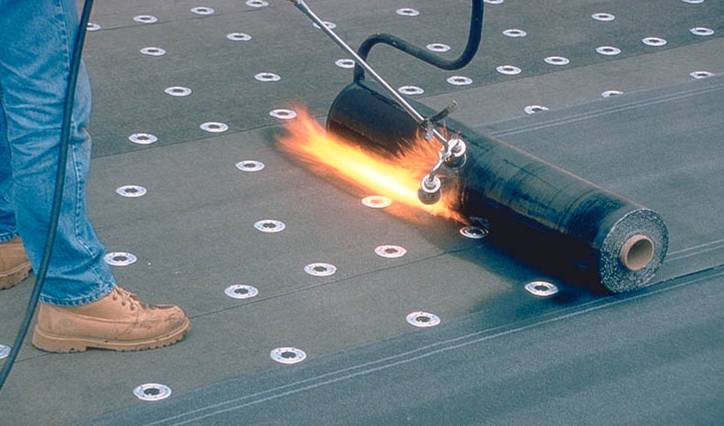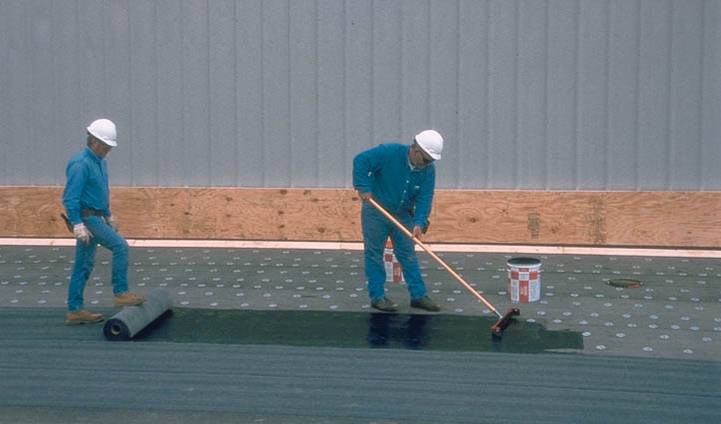Durability From a Timeless Product
Installation options
Modified bitumen systems consist of at least two layers: a base sheet and a cap sheet. An additional base sheet may be mechanically attached to the roof deck in cases where the application requires. Both SBS and APP sheets can be torch applied, cold applied or self-adhered. However, APP is most commonly installed by torching due to the high temperatures required to get the material to flux or melt; cold-applied and self-adhered options for APP may not be readily available. Additionally, SBS has the ability to be hot mopped. This list of installation methods may not be exhaustive of all options available on the market as the industry is always changing and new products are introduced and discontinued (see Figure 5). It is not necessary for both layers of a modified bitumen system to be installed in the same manner.

Image courtesy GAF/Siplast
Figure 6. Installation options for modified bitumen systems.
Both APP and SBS modified rolls can be installed using a torch method. Torch application uses an open-flamed torch to heat the back side of the sheet to flux, or the point of softening the modified bitumen so that it will adhere to the substrate below as it cools. It is important to note that APP fluxes at a much higher temperature than SBS, so crews who are used to torching one style of sheet may initially struggle to torch the other style. Because of the lower temperatures at which SBS membranes soften, the seams of the membrane can be sealed using a welder similar to the method to seal seams of a single-ply membrane.

Photo courtesy GAF/Siplast
Installation of a modified bitumen roll using torch application.

Photo courtesy GAF/Siplast
Sealing the seams of an SBS membrane with a welder, similar to the method used to seal seams of a single-ply membrane.
The other hot method for applying asphaltic roof systems is called hot-mopping. This is the method used for BUR roofing but can be used for SBS systems as well. Hot mopping involves melting blocks of asphalt in a large kettle and spreading the melted asphalt on the roof with mops. In addition to being an adhesive, this method can provide additional redundancy to the SBS system as you have a thicker sheet that already provides waterproofing being embedded in a layer of asphalt which will act as its own waterproofing component.
SBS can also be installed using a cold-applied adhesive. For this method, a solvent-based or solvent-free liquid adhesive is applied to the roof surface or previously laid membrane and spread evenly using a tool such as a notched squeegee. The modified bitumen sheet is then rolled into the adhesive. This option is good for when asphaltic fumes, open flames, and kettles that can accompany hot-applied roofing are not permissible.

Photo courtesy GAF/Siplast
SBS modified bitumen rolls installed using a cold-applied adhesive.
Finally, self-adhered modified bitumen membranes are available, both for SBS and a few APP systems. A self-adhered membrane is installed by removing a release film off the back of an already rolled out membrane. The membrane is then rolled to ensure it adheres to the substrate below. This method can increase the speed of installation over other traditional methods. Self-adhered membranes do not produce unpleasant odors, fumes, or heat, an important factor installing on an occupied building.
Surfacing variety
Asphaltic assemblies need a top surface to provide protection from UV, excessive surface temperatures, to provide fire protection, and to provide puncture and roof traffic resistance. There are many options available to designers and owners depending on the desired aesthetic and roof use. These options include a flood coat of asphalt and mineral aggregate or gravel, a mineral-surfaced cap sheet, an elastomeric coating, or even a traditional fleeceback single-ply membrane.
The traditional method to complete a bitumen roof such as BUR is a flood coating of asphalt with embedded gravel. The gravel layer protects from UV degradation, roof traffic, storm damage, and wind debris. For this option to be successful, the roof structure below must be designed and built to accommodate the anticipated additional weight of the gravel.
One of the most common ways to surface an asphaltic roof assembly is with a mineral surfaced or granulated cap sheet. This sheet employs a modified sheet that is thicker and has the granules already factory applied to the sheet. This cap sheet provides UV protection and surfacing to protect from traffic. Bright white granules with a high solar reflective index (SRI) for projects that need to meet specific reflectivity requirements are also available.

Photo courtesy GAF/Siplast
Application of a cap sheet.
Some modified bitumen assemblies can also be surfaced with a coating. The coating can be a squeegee-applied glaze coat of Type 1 asphalt, an asphaltic-based clay emulsion coating or any number of elastomeric coatings such as silicone, acrylics or urethanes. The elastomeric coatings may not be as strong against debris or roof traffic, but there are multiple options with high SRI values.
Finally, a fleece-backed thermoplastic membrane can be the surfacing or cap for a modified system. These membranes can have high SRI values, are resistant to ponding water, are easy to repair and maintain, and may offer more resistance to certain chemicals. This type of “hybrid” system provides the redundancy of a modified system with the benefits of a thermoplastic membrane.









